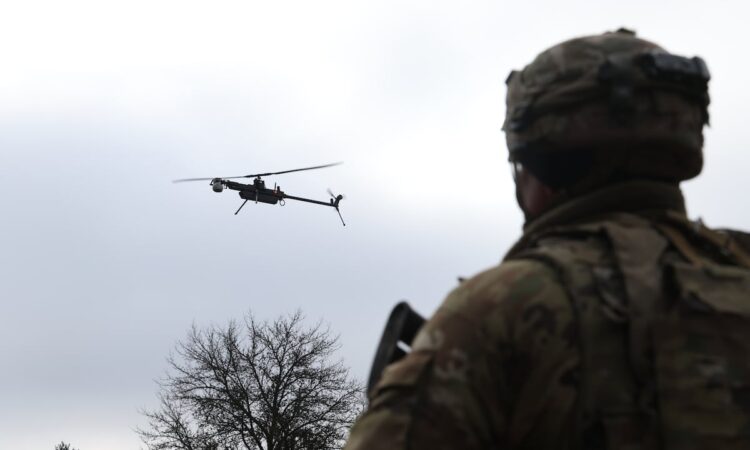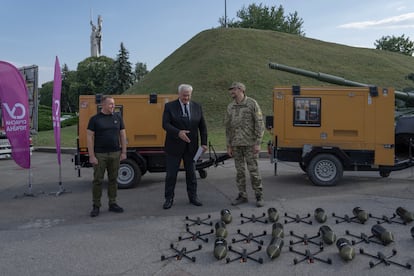Drones are changing the face of war and attracting multi-million dollar investments | Economy and Business

“It’s the biggest battlefield innovation in a generation.” Last July, U.S. Secretary of Defense Pete Hegseth acknowledged an open secret: drones have revolutionized not only the military industry, but also the face of warfare in the 21st century. Ukraine, making a virtue of necessity, has turned these unmanned aircraft into the keystone of its defense against the Russian invasion. And now it’s Moscow that has perfected these devices to counter Kyiv and to harass NATO by flying over the airspace of some of its member states, such as Poland.
At stake is not only military supremacy, but also billions of dollars. Dozens of startups want their share of a very juicy pie. The technological component of drones is key — the presence of artificial intelligence is increasingly dominant — and these startups are managing to lower prices and successfully compete against the giants of the arms industry. David is beginning to overshadow Goliath, and this has not gone unnoticed by investors. This is the only way to explain why the American drone manufacturer Anduril, founded in 2017, acquired a valuation of more than $30 billion in its latest funding round, or why Europe already has three unicorns (companies valued at over $1 billion) in this field: the German firms Quantum Systems and Helsing, and the Portuguese company Teketer.
Traditional defense companies are trying to contain the push from new players while muddying the waters. They claim drones fly too low and too slowly, while questioning the valuations some startups are achieving and suggesting the obsolescence of these devices. “[Drone warfare] has transformed the nature of war: a world where cheap drones can destroy ultra-expensive ships and planes changes the power dynamics and economics of combat,” British consultant and journalist Gillian Tett noted a few weeks ago in the Financial Times to explain the heavyweights’ discomfort.
Geopolitical tensions are playing into the hands of drone manufacturers. European Commission President Ursula von der Leyen announced a €2 billion investment in the Ukrainian army on September 29. What’s unique about this sum is that it will be earmarked for the acquisition and development of military drones. Since Russia invaded Ukraine in February 2022, the defending forces have sought to compensate for their numerical inferiority in military equipment and troops through the use of remote-controlled vehicles.
“Ukraine manufactured two million drones in 2024, a number that will double by 2025,” estimates Manuel Rodríguez Cerezo, director of weapons and ammunition at Spanish defense industry company Indra; “everything has arisen from the needs imposed by the war.” Manufacturing speed is key: a corvette can take between three and five years to build.
Russia — having lost strategic weapons to Ukraine and under pressure from an economy whose frame is beginning to creak under the weight of the war effort and international sanctions — has also begun to opt for low-cost remote-controlled vehicles, whether manufactured in-house or purchased from third countries, such as China (the world’s largest manufacturer) or Iran.
Many of these vehicles are not only used against Ukraine, but have also been harassing the borders of European Union countries and threatening critical infrastructure, such as submarine cables. Therefore, Europe has already made it a top priority to create an “anti-drone wall” on its borders, for which €6 billion will be allocated, in collaboration with Ukraine, which tests all types of these technologies on a daily basis and in combat.
Growth
In 2024, EU Member States’ defense spending increased for the tenth consecutive year, reaching €343 billion ($399 billion). In 2025, it is estimated it will reach €381 billion ($443 billion). This is also reflected in the capitalization of European companies in the sector, whose market value doubled between 2020 and 2024. At the latest edition of Feindef, the international defense fair held in Madrid, there was exponential growth in companies that, to a greater or lesser extent, manufacture or market military or dual-use drones.
But not all of them embrace the revolution represented by unmanned vehicles with the same enthusiasm. Armin Papperger, CEO of the German defense giant Rheinmetall, warned against the “drone bubble” in statements to The Wall Street Journal from the International Defense and Security Equipment Show in London, held last September. The German executive believes that the evolution of anti-aircraft systems and technologies that allow for the neutralization of swarms of these devices will cause them to lose their strategic (and market) value in the near future, although it is the case that Papperger was selling his Skynex anti-drone cannon system, which has been successfully tested in Ukraine.

“No one is clear about what an anti-drone wall should look like,” explains Miguel Tejeiro, director of innovation at TRC, a Spanish company that manufactures drone detection and neutralization equipment. “Neutralizing a traditional drone, which is basically an airplane, isn’t the same as neutralizing medium-sized drones like the Shahed (of Iranian origin and now manufactured in Russia) or small drones, which can cost €300 or less and to which you can attach an explosive charge that neutralizes equipment worth millions of euros.” It’s estimated that each time Israel uses the system known as the Iron Dome, it spends around €1 billion per activation. Does it make sense to use missiles that cost €1 million each to stop swarms of drones that cost €50,000?
Manuel Martín, director of defense at Arquimea, a company that manufactures marine drones like the S-Wise submarine, also present at the London fair, doesn’t share Papperger’s skepticism. “The change in the market has been very abrupt; demand has multiplied by 100 in three years.” Meeting this demand has allowed economies of scale and automation to reach an industry where it wasn’t so common. Until now. “Before, they could order one drone a year; now they can order one thousand to be delivered in six months,” explains Martín. “We’ve had to double our capacity; increase our staff, adapt our facilities, and we’ve robotized some of our processes,” he adds.
This sudden interest in the mass acquisition of drones has caught many of the sector’s major companies off guard, accustomed to projects that could take decades to develop and were designed to last up to 40 years, such as fighter jets, naval vessels, or the first drones; large aircraft like the Reaper or Predator, designed to be reused and operate from conventional airstrips. To use a simile, the manufacture of a modern military vehicle is very similar to that of a luxury car: they are assembled almost by hand by highly specialized personnel, involve enormous design work, and offer the customer unique materials and features. Medium and small drones, however, can be manufactured on assembly lines, use technology that is accessible to almost everyone, and offer a better starting point for small and medium-sized companies, which also have greater flexibility to adapt to changes, even switching from producing civilian-use aircraft to those for military use at low costs.
“In defense, more than 95% of companies are SMEs,” explains Rafael García, director of operations at the Etrair Group. “This boom has led to the emergence of new players in the sector, but it’s also necessary that what we offer has a solid foundation and reliable technology, especially with regard to systems that use artificial intelligence and reduce dependence on third parties.” To achieve this, García believes, the ideal scenario would be for large defense companies to partner with SMEs.
While these alliances are emerging, large companies are buying up smaller ones. For example, in July, Indra acquired Aertec DAS, a veteran Spanish drone production company that is now part of the multinational’s weapons and ammunition division. Its director, Manuel Rodríguez Cerezo, believes that, although the war in Ukraine has accelerated innovation in unmanned vehicles “on scales never seen before, using great doses of imagination,” changes in defense are slow and must be carried out prudently. Thus, Indra, in addition to continuing to produce Aertec’s Tarsis drones, has opted for the Valero system, based on medium-sized multifunction aerial drones, which can be used both for swarm attacks and for operating with a fighter jet. Rodríguez Cerezo doesn’t see the “drone bubble” that the Rheinmetall CEO warned about. “They’re here to stay, even if they don’t necessarily end up being used like they are in Ukraine. But we can learn a lot from what they’re doing, such as avoiding interceptions or developing navigation systems that don’t rely on satellites.”
What all the companies surveyed do agree on is that Spanish industry is ready to meet demand. And it’s also prepared to win contracts from companies in countries that have previously dominated the market, such as the U.S. and Israel. “Not only are we prepared, but we can also be proud as a country,” Martín emphasizes.
If everything on the supply side seems more or less ready to keep pace with the drone revolution, can the demand side do the same? When states are the buyers, money is not usually an issue, but the pace is dictated by general budgets, plans that must be drawn up and approved by committees, contracts and acquisitions regulated by law, and a bureaucracy that is as necessary as it is complicated. And also by each country’s own defense doctrine. “Changes in doctrine, however urgent, cannot be improvised, and new developments are gradually permeating,” explains David Ayala, general director of EINSA, which has developed a 100% Spanish all-terrain ground drone, which is being tested by the Spanish Legion’s Experimental Brigade.
While the Legion is performing testing, the Defense Ministry has launched 31 Special Modernization Plans (SMPs) totaling €36 billion, of which €10.47 billion will be invested this year. These SMPs are designed to update many traditional systems, such as self-propelled artillery and air transport, but there is also room for unmanned vehicles and the artificial intelligence systems that control them.
Very long cycles
“Our regulatory framework and the European one are very good because they establish quality requirements and foundations that offer many guarantees, but they can be somewhat rigid in circumstances like the current ones,” notes Miguel Tejeiro. For Manuel Rodríguez, the development cycles set by the Defense Ministry could be shortened, but he believes the industry must also do its part to achieve this. “I don’t think we’re slow in Spain,” affirms Manuel Martín, “what happens is that the threat is still very far away and we continue at the pace of peacetime.” And the truth is that the European allies have yet to agree on what the “anti-drone wall” on the borders with Russia should look like, nor on how to establish a “Drone Alliance” with Ukraine, which is more than willing to share knowledge in exchange for aid.
Some military personnel, such as Army Brigadier General and director of the Spanish Institute for Strategic Studies (IEEE), Víctor Mario Bados, offer an even more negative assessment. At a luncheon to which he was invited by the Madrid Family Business Association (ADEFAM), he gave his audience the following assessment: “Military capability is not improvised, and in Europe we lack some fundamental elements such as command and control, electronic warfare, drones, and satellites. We are paying the dividends of peace,” he said. “Europe has not been decisive with Putin, whom we have been unable to deter, hence the conflict resulting from the failure of deterrence.” He added that “politically, Europe is going through a difficult time, and Moscow knows it.”
Sign up for our weekly newsletter to get more English-language news coverage from EL PAÍS USA Edition




